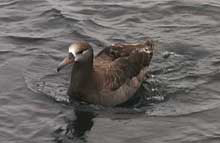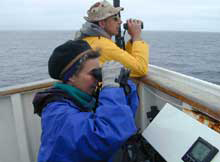
Blackfooted albatross travel to Olympic Coast National Marine Sanctuary from breeding grounds in Hawaii. (Photo: John Brooks) Click image for larger view.
Wings on the Flying Bridge
June 15, 2002
Robert Steelquist
Olympic Coast National Marine Sanctuary
During daylight hours, bird biologists Barb Blackie of Olympic Coast NMS and Scott Mills are on the flying bridge observing seabirds as the ship tracks along east-west transect lines about 35 miles long. Barb has studied seabirds in Alaska and Washington and worked as an observer on an OCNMS survey in 2000. Scott has worked as a consulting biologist—mostly on birds—for 30 years on projects from Nantucket to Molokai.
The seabirds we see are mostly tubenoses—a family of birds supremely adapted to life on the ocean. As a group, they are distinguished at close range by ducts on the beak where they exude excess salt. They include sooty and pink-footed shearwaters, black-footed albatross, storm-petrels and skuas.

With wingspans reaching up to 7 feet, blackfooted albatross soar over the swells. (Photo: John Brooks) Click image for larger view.
These birds spend nearly their entire lives at sea, flying gracefully over the swells in sustained glides punctuated with occasional forceful wing-beats. Using minute updrafts of wind as they flow over the waves, the birds conserve energy and appear to hang from their long outstretched wings. These birds are truly ocean citizens. Most sooty shearwaters breed in New Zealand. Pink-footed shearwaters breed off South America. Perhaps the roughest commute is that of the black-footed albatross. Birds rearing young in Hawaii have been documented flying to the West Coast of North America to feed, making the return trip back to the breeding grounds to feed their nestlings.
We also see the alcids, colony nesters from the offshore rocks and islands that include common murres, Cassin's and rhinoceros auklets, and tufted puffins. The alcids resemble footballs, flying low over the water with quick, determined wing beats. Offshore, they are gathering food—loading up on nutrients that will be necessary as they breed and rear young. We also see gulls, mostly a hybrid cross between glaucous-winged and Western gulls.

Barb Blackie and Scott Mills look for seabirds within 300 meters of the ship. (Photo: Robert Steelquist) Click image for larger view.
Barb and Scott record the seabirds they see within 300 meters of one side of the ship. The birds appear as tiny specks, gradually becoming discernable to the trained eyes of the biologists by flight patterns, shapes and plumage colors and patterns.
Tallying birds from the flying bridge alternates between lulls in activity, when just a few birds are visible, to intense bursts of scouting, pointing, naming and recording the birds as they bob in the waves or fly. We see a dense flock on the water, 100 meters off the port beam. I see a raft of birds. Barb counts 70 sooty shearwaters. There's one pink-footed shearwater in the middle of the flock. Scott Mills is at her elbow, calling out names and numbers as he quickly scans the water. The data are quickly entered into a computer.
The observers note fewer sooty shearwaters than we did two years ago but neither will speculate on how significant the information might be. “It would be dangerous to say anything if it sounded like a trend from looking from one year to the next, Barb cautions. “We need to look more closely, more often, for longer periods of time.”
Barb sums up the importance of the Olympic Coast seabird studies: “Seabirds are indicator species of ocean health, they are poorly studied and hard to study. It's very difficult to study them at sea. Getting these data are important—not just this one transect, but over many years we can get some idea of the population dynamics of these animals.”
Scott adds: “You have to try to understand what's going on in the environment before you start messing with it. We don't know fully what the impacts are of the activities we are doing now and it makes it difficult to make management plans and know how various activities will affect those resources. Without information such as this, you don't have a clue about what you are doing.”
In the spirit of Sanctuary Quest, these scientists are asking fundamental questions about the ocean, and gathering the most basic form of data— observations of an important group of organisms gathered the old-fashioned way. As the long day ends, both of the observers recognize that they are only scratching the surface. And tomorrow, if the weather holds, they'll continue adding small pieces of information to a much larger puzzle.


























